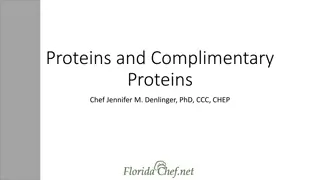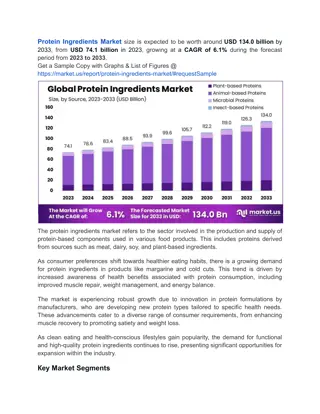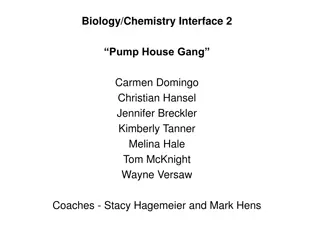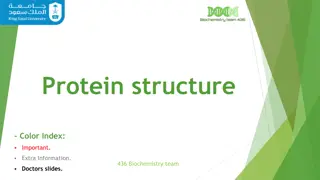Understanding Plasma Proteins and Their Functions
Plasma proteins play a crucial role in various physiological functions such as controlling extracellular fluid distribution and transportation of hormones, vitamins, and other substances. The balance between protein synthesis and catabolism determines protein levels in the vascular compartment, affe
6 views • 23 slides
Understanding Motor Proteins and Cytoskeletal Dynamics in Cell Biology
Motor proteins, such as myosin, kinesin, and dynein, utilize chemical energy to move along cellular tracks, influencing processes like muscle contraction, organelle movements, and cellular migration. With the ability to translocate using ATP hydrolysis, these proteins play crucial roles in various c
5 views • 14 slides
Comprehensive Overview of Protein Digestion in the Gastrointestinal Tract
Understanding the process of protein digestion is crucial for optimal nutrient absorption and overall health. In this lecture series by Professor Shraddha Singh, delve into the composition of proteins, the role of enzymes in protein digestion, sites of absorption, molecular basis of protein transpor
1 views • 28 slides
Understanding Active Transport and Osmosis in Biology
Substances can be absorbed against concentration gradients through active transport, requiring energy from respiration. Cells use transport proteins to move substances across membranes. Osmosis involves the movement of water across a selectively permeable membrane along concentration gradients. The
4 views • 12 slides
Understanding Cell Membrane Transport: Diffusion and Facilitated Diffusion
Cell membrane transport plays a crucial role in maintaining cellular functions by regulating the movement of substances across the membrane. Diffusion, a passive transport process, allows molecules to move from areas of high concentration to low concentration without energy expenditure. Within diffu
2 views • 20 slides
Understanding Passive and Active Transport in Cells
Explore the processes of diffusion, osmosis, and active transport in cells. Understand the similarities and differences between them, and learn why active transport is crucial for living organisms. Watch a video on active transport and answer related questions to deepen your knowledge. Enhance your
1 views • 12 slides
Understanding the Relationship Between DNA and Protein Specificity
The relationship between an organism's DNA and protein specificity is intricate. DNA encodes the information for the sequence of amino acids in proteins, thereby determining their specificity. This process involves DNA directing the synthesis of specific RNA molecules, which are then translated into
0 views • 17 slides
Proteins, Enzymes, and Gelatin: A Comprehensive Overview
Proteins are essential for the structure and function of living cells, while enzymes play crucial roles in various biological processes. Gelatin, derived from bones, skins, and tendons of animals, is a valuable substance with unique properties. This content explores the significance of proteins, the
0 views • 10 slides
Understanding Membrane Proteins and Cell Membrane Permeability
Cell membranes consist of phospholipid bilayers with embedded proteins, including integral and peripheral proteins. Integral proteins span the membrane, while peripheral proteins interact with the surface. Only non-polar molecules can pass through the membrane directly, while charged ions, polar mol
0 views • 30 slides
Understanding Proteins: Alternatives and Complementary Choices
Explore the world of proteins with a focus on alternatives to meat-based meals and the concept of complementary proteins. Discover different sources of protein, understand the difference between complete and incomplete proteins, and learn how to combine foods to ensure you're meeting all essential a
0 views • 9 slides
Understanding the Gibbs-Donnan Effect in Biological Systems
The Gibbs-Donnan Effect, named after physicists Gibbs and Donnan, explains the selective permeability of membranes to ions, leading to the establishment of Donnan potential. This phenomenon affects the distribution of ions and proteins across cell membranes, influencing processes like osmosis and io
0 views • 27 slides
HyTrEc2: Advancing Hydrogen Transport Economy in the North Sea Region
HyTrEc2, a project under the Interreg VB North Sea Programme, aims to promote green transport and mobility by implementing innovative hydrogen transportation solutions. With a vision to stimulate hydrogen-fueled transport for a sustainable future, the project focuses on developing zero-emission solu
0 views • 23 slides
Mechanisms of Nutrient Uptake by Microbial Cells
Nutrient uptake by microbial cells involves various transport mechanisms such as passive diffusion, facilitated diffusion, active transport, and group translocation. These mechanisms ensure the specific acquisition of required nutrients by the cell through the selectively permeable plasma membrane.
3 views • 15 slides
National Land Transport Amendment Bill 2018 Overview
The National Land Transport Amendment Bill of 2018 aims to address developments in the land transport system since 2009. It includes provisions for non-motorised and accessible transport, revises public transport contracting arrangements, clarifies government functions, streamlines operating license
0 views • 44 slides
Understanding the Structure and Role of Amino Acids in Proteins
Amino acids are building blocks of proteins, with distinct structures and properties. There are 20 common amino acids found in mammalian proteins, each with a carboxyl group, an amino group, and a unique side chain. The side chains determine the role of an amino acid in a protein, classified as nonp
8 views • 11 slides
Health-Conscious Consumers Boost Demand for Functional Protein Ingredients
Protein Ingredients Market; By Product Type (Microbe-Based Proteins, Animal Proteins, Plant Proteins, and Insect Proteins); By Application (Infant Formulations, Animal Feed, Food & Beverages); By Region and Companies - Industry Segment Outlook, Marke
0 views • 4 slides
Understanding Plasma Proteins in Biochemistry Lectures
This informative content discusses the types, functions, and measurement of plasma proteins in biochemistry. It covers the importance of identifying various plasma proteins, their roles in disease diagnosis, and the interpretation of electrophoretic patterns. The lecture overview provides insights i
0 views • 30 slides
Understanding Proteins: Functions, Structure, and Breakdown
Explore the world of proteins, from their essential functions in living organisms to the chemistry of amino acids that form them. Learn how proteins are structured, the significance of amide links, and how they are broken down through hydrolysis. Delve into the importance of essential amino acids an
0 views • 17 slides
Amino Acid Absorption Mechanisms in Small Intestine
Amino acid absorption in the small intestine is an active process requiring energy derived from ATP hydrolysis. It involves two main mechanisms: carrier proteins transport system and glutathione transport system. The carrier proteins transport system uses ATP energy for absorption, while glutathione
0 views • 18 slides
Understanding Amino Acids, Peptides, and Proteins in Organic Chemistry
Amino acids, peptides, and proteins are essential components in biological processes. Proteins are polymers made up of amino acid units linked by peptide bonds, while peptides are important in various biological functions. The structure and classification of amino acids play a vital role in the stru
0 views • 15 slides
Understanding Allergies to Animals and Living Organisms
Allergies to animals and living organisms are a result of specific immune processes triggered by allergenic substances like proteins and peptides. This allergic response can be caused by various animal proteins such as dog allergens Can f.1, Can f.2, and Can f.3, and cat allergen Fel d1. The represe
1 views • 10 slides
Understanding Protein Synthesis and Translation Process
Proteins play a crucial role in various body structures and functions. The process of translation, as per the central dogma, involves converting genetic information from DNA to functional proteins through transcription and translation. This process includes initiation, elongation, and termination st
1 views • 25 slides
Understanding Cell Membrane Structure and Proteins
Exploring the basic structure of membranes, the distribution of proteins within the membrane, intrinsic vs. extrinsic proteins, the fluid mosaic model, phospholipids forming the bilayer, the role of hydrophilic and hydrophobic parts in phospholipids, polysaccharides, and the differences between glyc
0 views • 18 slides
Key Notables in NLTA Amendment Bill for Integrated Transport Network
Presentation by Mr. R. Lungile Mabece at the 38th Southern Africa Transport Conference focusing on notable changes in the National Land Transport Act (NLTA) Amendment Bill and implications for implementing an Integrated Public Transport Network (IPTN). The presentation discusses key developments, im
0 views • 16 slides
Understanding Cellular Membrane Transport in Biology/Chemistry Interface 2
Explore the teachable unit on membrane transport in an introductory biology class for majors to understand how cells exchange substances with their environment. The unit covers selective membrane permeability, membrane transport mechanisms, proteins involved, physiological importance, and outcomes o
0 views • 23 slides
Understanding Active Transport in Cells
Active transport allows cells to move molecules against their concentration gradients by using energy and carrier proteins. This process requires ATP, involves carrier proteins acting as pumps, and is selective in the molecules it transports. The Na+/K+ATPase pump is a key example of active transpor
0 views • 44 slides
Understanding Membrane Transport Processes in Plant Cells
Plant cells are separated from the environment by plasma membranes, which facilitate the movement of molecules through passive and active transport mechanisms. Transport proteins play a crucial role in allowing the movement of ions and polar molecules, with channels, carriers, and pumps enhancing so
0 views • 20 slides
Comprehensive Overview of Transport Operations
Explore the various aspects of transport management including mechanisms for ensuring a smooth flow of goods, freight characteristics, criteria for selecting vehicles, lorry fleet management, ground transport capacities, and factors influencing transport decisions. Learn about managing lorry fleets,
0 views • 10 slides
Understanding Membrane Transport in Plant Cells
Plant cells rely on membrane transport to facilitate the movement of molecules across their plasma membrane. This process involves passive and active transport mechanisms, with the help of specialized proteins such as channels, carriers, and pumps. Channels serve as selective pores for ions and wate
0 views • 20 slides
Uganda Transport Sector Development Partners Group Priorities FY 19/20
This document outlines key priorities identified by the Uganda Transport Sector Development Partners Group for the fiscal year 2019/2020. The priorities include institutional framework optimization, legislative reforms, preparation of policy reports, and capacity-building initiatives within the tran
0 views • 6 slides
Qualitative Tests of Proteins & Amino Acids - Lab Analysis Overview
This lab analysis covers qualitative tests for proteins and amino acids, including solubility tests and identification tests for amino acids and proteins. Specific tests like Ninhydrin test for -L amino acids, Xanthoproteic test for aromatic amino acids, and lead sulfite test for sulfhydryl group de
0 views • 13 slides
Impact of Transit Oriented Development on Public Transport: Case Cornubia
Investigate the influence of Transit Oriented Development (TOD) factors on the public transport system, including improved public transport density, mixed-use design, and pedestrian-friendly infrastructure. This paper explores the theoretical application of TOD in urban planning with a focus on the
0 views • 16 slides
Cellular Processes and Functions Explained
The cytoplasm is essential for cell function, housing organelles like chloroplasts and vacuoles unique to plants. Mitochondria facilitate cellular respiration, while amino acids form proteins. Enzymes are proteins, and carbohydrates consist of simple sugars. Basic pH numbers range from 8 to 14. Star
0 views • 24 slides
Understanding Biomembranes: Composition, Structure, and Functions
Biomembranes, specifically the plasma membrane, play a crucial role in cell function by separating and protecting the cell, facilitating communication with the environment, and regulating transport processes. Composed of lipids, proteins, and carbohydrates, membranes have a fluid mosaic structure wi
0 views • 13 slides
Understanding Protein Structure and Function in Biochemistry
Proteins play vital roles in the body as large, complex molecules made up of amino acids. Understanding peptide bonding, levels of protein structure, and forces stabilizing proteins is crucial. Explore how protein misfolding can lead to diseases like Alzheimer's. Learn about the primary structure an
0 views • 26 slides
Understanding Beta Pleated Sheet Structure in Proteins
Beta pleated sheet structure is a secondary structure found in proteins where peptide chains lie side by side to form a flat sheet held together by hydrogen bonds. Proteins like keratin and fibroin exhibit this structure, while denaturation can alter the secondary and tertiary structures of proteins
0 views • 9 slides
Understanding the Roles of Kinesin and Dynein in Cellular Transport
Explore the functions of Kinesin and Dynein, two vital motor proteins involved in intracellular transport. Kinesin drives anterograde movement, while Dynein facilitates retrograde transport along microtubules in cells. Discover the structure, mechanism, and functions of these essential proteins in c
0 views • 19 slides
Understanding Proteins: Structure and Function
Proteins are vital organic compounds composed of amino acids linked by peptide bonds. They serve various functions in cells, such as enzymes and hormones. Amino acids are the building blocks of proteins, with 20 different types forming all proteins on Earth. Proteins have four levels of structure -
0 views • 12 slides
Enhancing Freight Transport Coordination in Trans Tritia Project Territory
Improving freight transport coordination and planning in the Trans Tritia project territory covering Poland, Czech Republic, Slovakia, and specific regions aims to address territorial challenges, enhance regional integration, and foster cross-border cooperation. The project, co-financed by the Europ
0 views • 15 slides
Classification of Proteins in Animal Nutrition: Simple Proteins vs. Conjugated Proteins
Proteins in animal nutrition are classified into two main groups: simple proteins and conjugated proteins. Simple proteins can be further divided into fibrous and globular proteins based on their shape, solubility, and chemical composition. Fibrous proteins, such as collagens, elastin, and keratins,
0 views • 18 slides







































